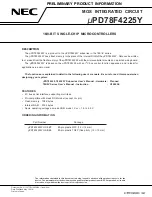...the world's most energy friendly microcontrollers
2014-01-23 - an0820_Rev1.00
9
www.silabs.com
Figure 2.7. Parity Error and Re-transmission for the T=0 Protocol
Procedure
byt e
Sm art Card
Sm art Card
Term inal
7816- 3, T= 0 Prot ocol
SW1 SW2
CLA INS
P1
P2
P3
DATA
INS
Parit y
Error
Single Byt e
Ret ransm it t ed
For further explanation of CLA the (class byte), INS (instruction) and P1-3 (parameters) and their
contents in the T=0 protocol, please see the 7816 standard, (Reference 4 (p. 20) ).
2.3.3 T=1 Protocol Introduction
The T=1 protocol is more complex than the T=0 protocol. The physical interface is still half-duplex and
uses the same configuration as T=0. T=1 is actually built on top of T=0, but it does not use the T=0
error correction functionality, rather it uses a block oriented protocol. The main benefits of T=1 is the
block-oriented error detection mechanism which provides much better error detection and correction
capabilities than T=0. For more information about this protocol, please see Reference 2 (p. 20) .
Summary of Contents for EFM32
Page 27: ......


















